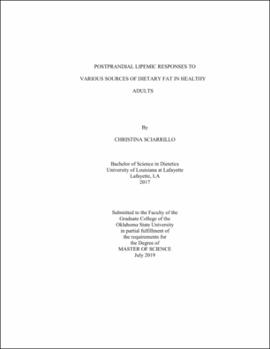| dc.contributor.advisor | Emerson, Sam R. | |
| dc.contributor.author | Sciarrillo, Christina | |
| dc.date.accessioned | 2023-09-21T18:57:23Z | |
| dc.date.available | 2023-09-21T18:57:23Z | |
| dc.date.issued | 2019-07 | |
| dc.identifier.uri | https://hdl.handle.net/11244/339604 | |
| dc.description.abstract | Postprandial lipemia (PPL) has been identified as an independent risk factor for cardiovascular disease (CVD) and a stronger predictor of CVD risk than fasting triglycerides (TG). However, the effects of various sources of commonly consumed dietary fat on PPL are not well understood. Therefore, the objective of this project was to examine the postprandial TG response to commonly consumed sources of dietary fat in healthy adults. Participants engaged in 4 randomized meal trials separated by at least 1 week. For each meal trial, following a 10-hour overnight fast, participants (n = 10; 5M/5F) consumed a standard high-fat meal (HFM; 13 kcal/kg; 61% fat, 32% CHO) with the fat source derived from either butter (B), virgin unrefined coconut oil (CoO), extra virgin olive oil (OO), or canola oil (CaO). Serial blood draws were collected hourly for 6-hours post-meal to quantify postprandial TG responses. Fasting TG was not different (p = 0.39) across trials. Two-way ANOVA revealed a significant time effect (p < 0.0001) but no time x meal interaction (p = 0.56) or overall meal effect (p = 0.35). Meal trials did not differ with regard to TG total (p = 0.33) or incremental (p = 0.14) area under the curve. Men exhibited significantly higher TG peak (p < 0.05) within every meal trial. When data were stratified by sex and the TG response was averaged for each participant, a two-way ANOVA revealed a significant time effect (p < 0.0001), time x group interaction (p = 0.0001), and group effect (p = 0.048). Men had significantly higher TG than women at every time point in the postprandial period (p < 0.05). BMI was strongly associated with TG tAUC (r = 0.79, R² = 0.63, p = 0.006). In our sample of young healthy adults, acute postprandial TG responses to a single HFM comprised of different dietary fat sources did not significantly differ. Additionally, our findings support the notion that sex and BMI are important determinants of PPL. Future research should determine PPL responses to different fat sources in participants at greater risk for CVD. | |
| dc.format | application/pdf | |
| dc.language | en_US | |
| dc.rights | Copyright is held by the author who has granted the Oklahoma State University Library the non-exclusive right to share this material in its institutional repository. Contact Digital Library Services at lib-dls@okstate.edu or 405-744-9161 for the permission policy on the use, reproduction or distribution of this material. | |
| dc.title | Postprandial lipemic responses to various sources of dietary fat in healthy adults | |
| dc.contributor.committeeMember | Smith, Brenda J. | |
| dc.contributor.committeeMember | Lucas, Edralin A. | |
| osu.filename | Sciarrillo_okstate_0664M_16166.pdf | |
| osu.accesstype | Open Access | |
| dc.type.genre | Thesis | |
| dc.type.material | Text | |
| dc.subject.keywords | butter | |
| dc.subject.keywords | coconut oil | |
| dc.subject.keywords | lipids | |
| dc.subject.keywords | postprandial lipemia | |
| dc.subject.keywords | saturated fat | |
| dc.subject.keywords | triglycerides | |
| thesis.degree.discipline | Nutritional Science | |
| thesis.degree.grantor | Oklahoma State University | |
